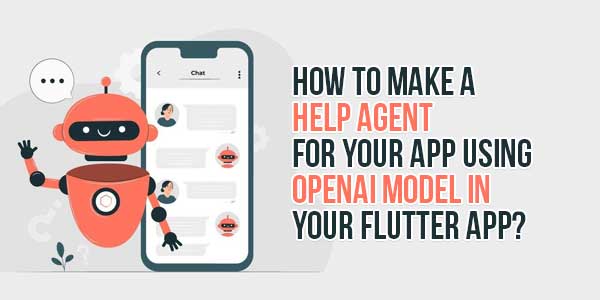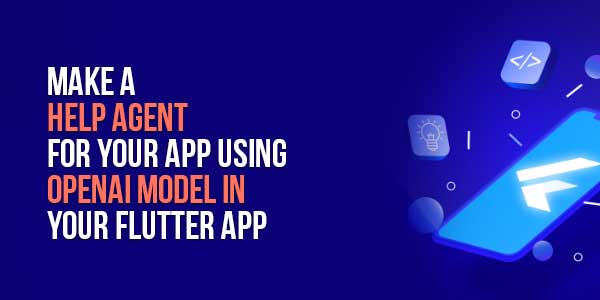
Table of Contents
How To Make A Help Agent For Your App Using OpenAI Model In Your Flutter App
In today’s competitive app market, providing instant support can make or break user experience. Imagine having an intelligent help agent that answers user queries 24/7 without human intervention. By combining Flutter’s cross-platform capabilities with OpenAI’s powerful language models, you can create a sophisticated help agent that elevates your app’s functionality.
“AI-powered help agents can reduce customer support costs by up to 30% while improving response times dramatically.” – Gartner Research
Why Add An AI Help Agent To Your Flutter App?
Before diving into implementation, let’s understand why this integration matters:
- Instant Support: Users get immediate answers to their questions
- Reduced Workload: Decreases pressure on human support teams
- 24/7 Availability: Operates round-the-clock without breaks
- Multilingual Support: Can communicate in multiple languages effortlessly
- Scalability: Handles thousands of queries simultaneously
Prerequisites For Implementation
To follow this guide, you’ll need:
- Basic knowledge of Flutter and Dart
- Flutter development environment set up
- OpenAI API key (available at platform.openai.com)
- Dart HTTP package installed in your project
Step 1: Setting Up Your Flutter Project
Begin by creating a new Flutter project or using an existing one:
Create A New Flutter Project
Run the following command in your terminal:
flutter create ai_help_agent cd ai_help_agent
Add Required Dependencies
Open your pubspec.yaml file and add these dependencies:
dependencies:
flutter:
sdk: flutter
http: ^0.13.4
flutter_dotenv: ^5.0.2Run flutter pub get to install the packages.
Step 2: Configuring The OpenAI API Connection
The heart of your help agent will be the OpenAI API. Here’s how to connect it securely.
Securing Your API Key
Never hardcode API keys in your app. Instead:
- Create a
.envfile in your project root - Add your OpenAI API key:
OPENAI_API_KEY=your_api_key_here - Add
.envto your.gitignorefile
Creating The API Service Class
Create a new file openai_service.dart with this basic structure:
import 'dart:convert';
import 'package:http/http.dart' as http;
import 'package:flutter_dotenv/flutter_dotenv.dart';
class OpenAIService {
final String _apiKey = dotenv.env['OPENAI_API_KEY']!;
final String _baseUrl = 'https://api.openai.com/v1/chat/completions';
Future<String> getHelpResponse(String userQuery) async {
try {
final response = await http.post(
Uri.parse(_baseUrl),
headers: {
'Content-Type': 'application/json',
'Authorization': 'Bearer $_apiKey',
},
body: jsonEncode({
'model': 'gpt-3.5-turbo',
'messages': [
{
'role': 'system',
'content': 'You are a helpful assistant for our mobile app. '
'Provide concise, friendly answers to user questions.'
},
{'role': 'user', 'content': userQuery}
],
'temperature': 0.7,
'max_tokens': 150
}),
);
if (response.statusCode == 200) {
final data = jsonDecode(response.body);
return data['choices'][0]['message']['content'];
} else {
throw Exception('Failed to get response: ${response.body}');
}
} catch (e) {
return 'Sorry, I encountered an error. Please try again later.';
}
}
}Step 3: Designing The Help Agent Interface
A good UI makes the chatbot interaction intuitive and pleasant.
Creating The Chat Interface
Build a basic chat screen with these components:
- Message history list
- Input text field
- Send button
- Typing indicator
Sample Chat Widget Implementation
import 'package:flutter/material.dart';
import 'openai_service.dart';
class HelpAgentScreen extends StatefulWidget {
const HelpAgentScreen({super.key});
@override
State<HelpAgentScreen> createState() => _HelpAgentScreenState();
}
class _HelpAgentScreenState extends State<HelpAgentScreen> {
final OpenAIService _openAIService = OpenAIService();
final TextEditingController _messageController = TextEditingController();
final List<Map<String, dynamic>> _messages = [];
bool _isTyping = false;
void _sendMessage() async {
if (_messageController.text.isEmpty) return;
final userMessage = _messageController.text;
_messageController.clear();
setState(() {
_messages.add({'text': userMessage, 'isUser': true});
_isTyping = true;
});
try {
final aiResponse = await _openAIService.getHelpResponse(userMessage);
setState(() {
_messages.add({'text': aiResponse, 'isUser': false});
_isTyping = false;
});
} catch (e) {
setState(() {
_messages.add({
'text': 'Sorry, I encountered an error. Please try again.',
'isUser': false
});
_isTyping = false;
});
}
}
@override
Widget build(BuildContext context) {
return Scaffold(
appBar: AppBar(title: const Text('Help Agent')),
body: Column(
children: [
Expanded(
child: ListView.builder(
padding: const EdgeInsets.all(8),
itemCount: _messages.length,
itemBuilder: (context, index) {
final message = _messages[index];
return Align(
alignment: message['isUser']
? Alignment.centerRight
: Alignment.centerLeft,
child: Container(
margin: const EdgeInsets.symmetric(vertical: 4),
padding: const EdgeInsets.all(12),
decoration: BoxDecoration(
color: message['isUser']
? Colors.blue[100]
: Colors.grey[200],
borderRadius: BorderRadius.circular(12),
),
child: Text(message['text']),
),
);
},
),
),
if (_isTyping)
const Padding(
padding: EdgeInsets.all(8.0),
child: Align(
alignment: Alignment.centerLeft,
child: Text('Assistant is typing...'),
),
),
Padding(
padding: const EdgeInsets.all(8.0),
child: Row(
children: [
Expanded(
child: TextField(
controller: _messageController,
decoration: const InputDecoration(
hintText: 'Type your question...',
border: OutlineInputBorder(),
),
onSubmitted: (_) => _sendMessage(),
),
),
IconButton(
icon: const Icon(Icons.send),
onPressed: _sendMessage,
),
],
),
),
],
),
);
}
}
Step 4: Enhancing Your Help Agent
Basic implementation works, but these improvements will make it production-ready.
Adding Context Awareness
Make your agent smarter by including app-specific context:
// Modify the system message in your API call
'messages': [
{
'role': 'system',
'content': 'You are a helpful assistant for [Your App Name], '
'which is a [describe your app]. '
'Current app version: 2.1.0. '
'Focus on helping with [key app features]. '
'Be friendly but professional.'
},
{'role': 'user', 'content': userQuery}
]Implementing Conversation History
For more natural conversations, maintain context by sending previous messages:
// Keep track of conversation history in your state
List<Map<String, String>> _conversationHistory = [];
// Modify your API call to include history
'messages': [
{
'role': 'system',
'content': '...your system message...'
},
..._conversationHistory.map((msg) => {
'role': msg['isUser'] ? 'user' : 'assistant',
'content': msg['text']
}).toList(),
{'role': 'user', 'content': userQuery}
]Step 5: Testing And Optimization
Thorough testing ensures your help agent works reliably.
Testing Strategies
- Unit Testing: Verify API calls and response handling
- UI Testing: Check message display and input handling
- Scenario Testing: Test common user queries
- Edge Cases: Test with empty inputs, long messages, etc.
Performance Optimization Tips
- Implement response caching for common queries
- Add rate limiting to prevent API abuse
- Use streaming for faster response display
- Optimize message history management
Advanced Features To Consider
Take your help agent to the next level with these enhancements:
Multimodal Capabilities
Combine text with other input/output modes:
- Voice input/output using speech-to-text
- Image recognition for visual queries
- Rich media responses (links, buttons)
Integration With App Features
Make the agent more powerful by connecting it to app functionality:
// Example: Allow the agent to trigger app actions
if (aiResponse.contains('{open_settings}')) {
Navigator.push(context, SettingsScreen());
// Remove the special token from displayed message
aiResponse = aiResponse.replaceAll('{open_settings}', '');
}Common Challenges And Solutions
Be prepared to handle these typical issues:
Handling API Limits And Costs
- Implement token counting to stay within limits
- Add user authentication for premium features
- Cache frequent responses to reduce API calls
Managing Inappropriate Responses
Add content moderation layers:
// Add moderation check before displaying response
final needsModeration = await _checkModeration(aiResponse);
if (needsModeration) {
aiResponse = "I can't answer that question. Please contact support.";
}Conclusion: Elevating Your App With AI Assistance
Integrating an OpenAI-powered help agent into your Flutter app can transform user experience while reducing support costs. By following this guide, you’ve learned to:
- Set up the Flutter project with necessary dependencies
- Connect securely to the OpenAI API
- Design an intuitive chat interface
- Enhance basic functionality with advanced features
- Test and optimize the implementation
Remember that AI help agents work best when complementing (not replacing) human support. Start with a basic implementation, gather user feedback, and gradually add more sophisticated features based on real usage patterns.
“The best AI implementations are invisible – users simply experience better service without noticing the technology behind it.” – AI Product Design Principle
With your new AI help agent in place, you’re well on your way to creating more engaging, responsive, and intelligent mobile experiences that keep users coming back.


















Be the first to write a comment.